
Strategies to increase social media engagement: Metrics to track for success
While social media engagement is a key indicator of a brand's online success, measuring your engagement demands more than simply counting your 'likes', ‘comments’, and 'shares.'
To unlock the full potential of social media platforms and foster a deeper connection with your audience, it's essential to adopt a strategic, data-informed approach. By understanding the right metrics to measure, employing effective strategies to boost engagement, and harnessing the power of social media analytics tools, like Pulsar CORE, brands can transform their social media presence into a vibrant and engaging space.
So where do you begin? Let’s get into it.
Table of Contents
- What is social media engagement?
- The top 7 social media metrics to track
- Engagement rate
- Reach
- Impressions
- Click-through rate (CTR)
- Conversion rate
- Audience/ follower growth rate
- Response time
- The top 7 ways to increase social media engagement
- Create engaging content relevant to your audience
- Keep up-to-date with topical events and trends
- Engage with your audience
- Keep your feed fresh and active
- Know what time to post
- Use hashtags strategically
- Make use of paid promotions
- How traditional methods of measuring and increasing social media engagement have evolved
- Enhancing your social media engagement strategy
What is social media engagement?
Social media engagement is the umbrella term for measuring how users interact with your posts and profiles across the various platforms. While engagement may look or refer to something slightly different depending on which platform you’re analyzing, whether it’s a ‘like’, ‘comment’ or ‘share’ on Facebook and Instagram or ‘repost’ or ‘quote’ on X (previously Twitter), the essence is the same: it's about gauging how much your content resonates with your audience.
But tallying likes, comments, and shares only scratches the surface when measuring social media engagement. To truly understand your brand's digital footprint, you need to dig deeper into specialized metrics that offer a nuanced view of audience interaction and its impact on your business goals.
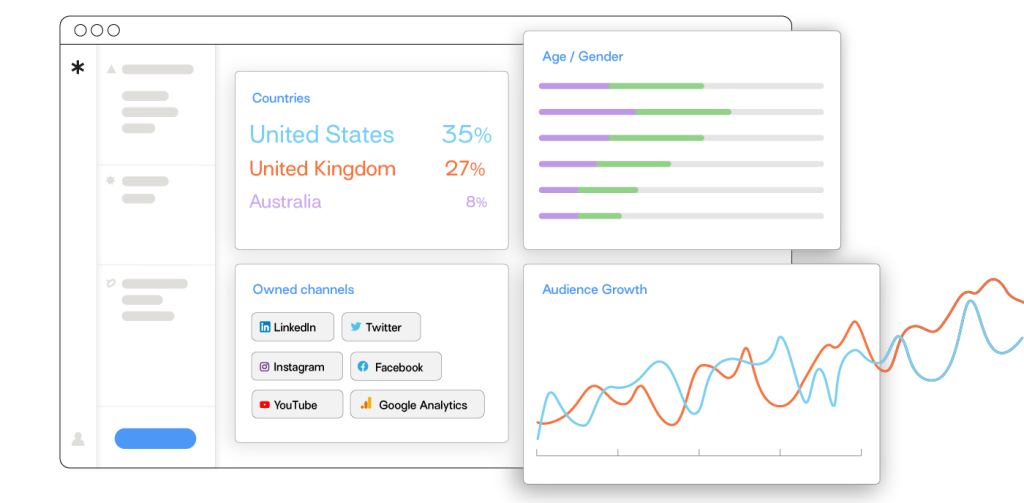
Next, let's dive into the top 7 metrics to enrich your strategy and boost your social media engagement.
The top 7 social media metrics to track
First things first, what are social media metrics? Social media metrics are data points that allow you to assess the progression of your social media performance. Metrics come in various shapes and sizes, but in general, they’re essential for understanding the areas where you’re experiencing social success and where there’s room for improvement.
These are our top recommendations for the social media metrics you should be paying attention to:
1. Engagement rate
Engagement rate quantifies how actively your audience interacts with your content or campaigns. While the type of engagement - likes, comments, shares, or saves - can differ depending on the platform, the concept remains the same. It's important to note that there's more than one way to slice this metric. You could base your engagement rate on your follower count, but you might also want to consider including engagement from users who aren't following you but still interact with your content. For even more depth, refine your strategy with Pulsar CORE by tracking micro-engagements as well as conventional interactions. These are subtle actions like clicks or full-screen views that don't include retweets, comments, or shares. With Pulsar CORE, you can monitor these low-key yet valuable engagements on your Twitter profiles to better understand user behavior.
2. Reach
Reach is straightforward - it refers to the total number of people who have seen your content. However, it's vital not to overlook the nuance by breaking down your reach into followers and non-followers as mentioned above. If a fair share of non-followers interacts with your content, that's a strong indicator that posts are resonating beyond your immediate audience through widespread sharing or algorithmic favor.
3. Impressions
Impressions tally the total views of your post, and it's often a more substantial number than reach because it counts multiple views by the same user. A high impression count can be exciting but calls for deeper analysis. Are the impressions translating to actual engagement? If not, you've got visibility but may be missing a connection with your audience. Investigate what sets this high-impression post apart from others - what draws viewers back? Most importantly, think about conversion. A high number of impressions is an untapped potential; consider leveraging this visibility into actionable results, like clicks, shares, or sales.
4. Click-through rate (CTR)
Engagement, reach, and impressions paint a broad picture of audience interaction, but the click-through rate (CTR) focuses on those willing to take the next step. Consider CTR a critical metric because it reveals the extent to which your content sparks enough curiosity for people to want more. CTR measures the percentage of viewers who clicked a link in your post -whether that's a link to a blog article or your website homepage. A high CTR doesn't just indicate interest; it also funnels organic traffic to your website, offering further opportunities for conversion and engagement.
5. Conversion rate
While CTR gives you a glimpse into the curiosity your content sparks, the conversion rate is the metric that turns that curiosity into concrete actions—like sales, sign-ups, downloads, or demo requests etc. This metric is crucial as it translates your social media interactions into concrete outcomes, offering a direct assessment of your posts' contribution to your business objectives in a tangible way.
6. Audience/ follower growth rate
Your audience growth rate quantifies the increase in followers over a defined period, reflecting the expanded circle of users who don't just engage with your posts but want to keep tabs on your content. But calculating this rate isn't just about adding up new followers. It involves determining your follower growth as a proportion of your existing audience to offer a more nuanced understanding of your social media performance.
7. Response time
In addition to tracking social media marketing metrics, don't overlook the importance of social customer service performance indicators for a well-rounded understanding of your performance. One key metric is average response time, which gauges the speed at which your customer service team addresses queries across your social platforms - from direct messages about orders to public tweets expressing concerns about your service. Effective social media strategy extends beyond crafting engaging content and maintaining audience attention. It's also about fostering a community that perceives your brand as attentive, reliable, and trustworthy, ultimately nurturing long-term relationships with devoted customers.
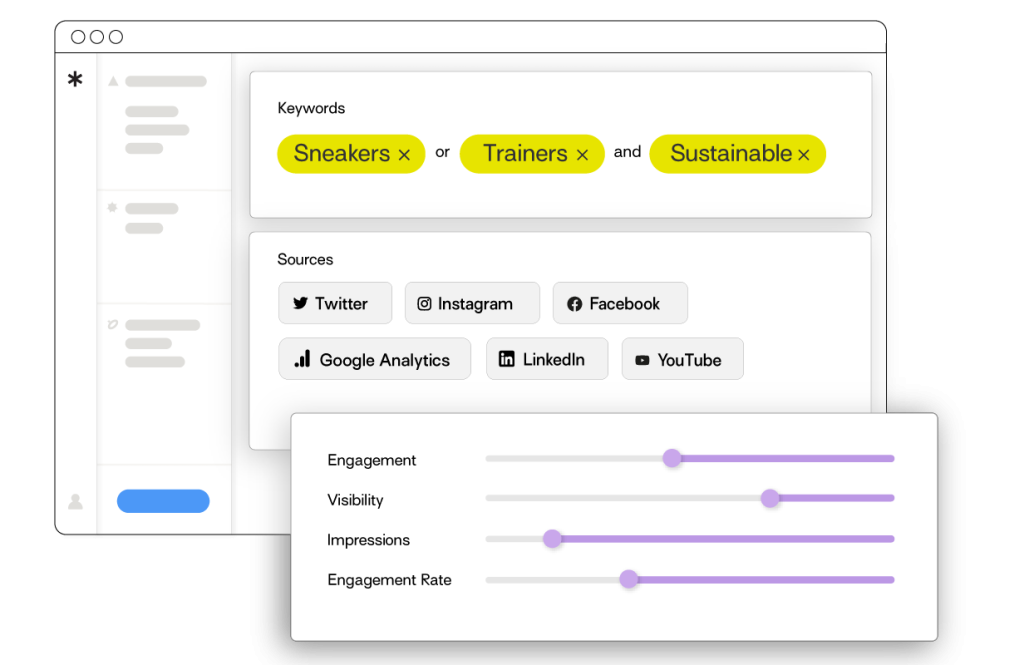
The top 7 ways to increase social media engagement
Now that you're armed with the metrics that matter - let's explore the top 7 strategies to boost your social media engagement. If your data deep-dive has spotlighted both opportunities and weak spots, your first action is to level up that engagement.
1. Create engaging content relevant to your audience
While it seems like a no-brainer - nobody aims to churn out snooze-worthy posts. Let's be real: Making content pop is more than just eye-catching visuals or a consistent color palette. It's not even about just tossing in a joke or two. Instead, it’s about truly understanding your audience's needs and desires, aligning that with your brand's purpose, and meshing it all with your broader business objectives. So, if you're keen on ramping up your social media engagement, start with content that speaks directly to your audience's interests and your brand's goals.
2. Keep up-to-date with topical events and trends
Staying plugged into current events and trends keeps your brand relevant while offering a golden opportunity to engage meaningfully with your audience. To catch more eyeballs and spark conversations, be timely and topical in your social media posts. Remember, however, keeping content relevant and engaging is first and foremost - don't just jump onto trends for views - the best content should mean something to your audience. Research subjects and topics trending within your industry and create a post around it, whether an event, a new release, etc.
3. Engage with your audience
We've touched on the importance of quick response times, but active social media presence goes beyond addressing customer queries or complaints. It's about building genuine relationships with your audience and lending a human touch to your brand. Brands that showcase personality, rather than a faceless corporate image tend to perform better. Don't be afraid to start conversations, chime in on comments, and let your brand's personality shine through your content.
4. Keep your feed fresh and active
Maintaining an active social media presence isn't just about customer interactions; it also means consistently delivering quality content. Instead of posting just for the sake of posting, aim for purpose-driven content that resonates with your audience. To make this manageable, curate a well-planned posting schedule and utiliza social media scheduling platforms - ensuring your messaging is strategic and time-efficient.
5. Know what time to post
Understanding the optimal times to post on each platform can significantly boost your content's visibility. While general research suggests certain peak hours - like CoSchedule's findings that Monday, Wednesday, and Friday at 7:00 PM, 3:15 PM, and 8:41 AM are ideal for posting - it's crucial to dig deeper. Individual platforms have their own user behavior patterns, so tailor your posting schedule accordingly to maximize reach.
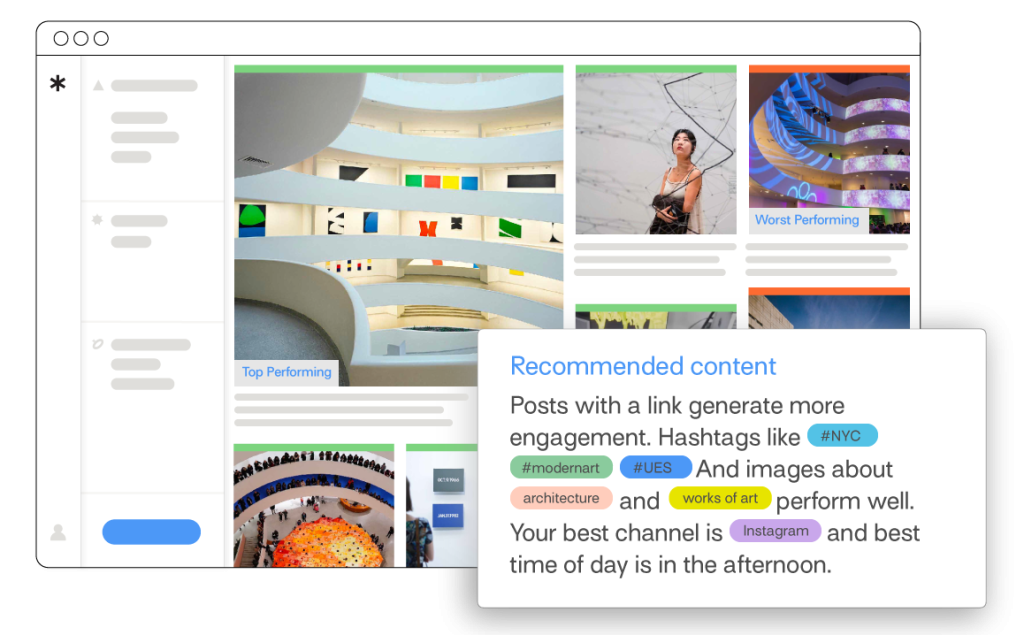
6. Use hashtags strategically
While hashtags may be most associated with X (previously Twitter), they've gained traction on other social media platforms. Using hashtags in your posts places your brand in the middle of current conversations, linking your content to like-minded users actively interested in your industry and opening up more opportunities for engagement. To increase your post's discoverability, keep an eye on trending hashtags and stay updated on news and events related to your field.
7. Make use of paid promotions
While organic impressions are great for engaging with your existing community, paid promotions can help you tap into new audiences. Start by researching who you'd like to target. Then, craft posts that resonate with those specific groups to drive more engagement. Get the most out of your ad spend by setting clear objectives, allocating your budget wisely, pinpointing your target demographics, and determining which metrics you'll use to gauge success.
How traditional methods of measuring and increasing social media engagement have evolved
Traditional methods of tracking social media engagement, which often include counting likes, shares, and followers, have limitations. While useful for a quick snapshot of reach and general performance, they lack the depth to provide actionable insights on meaningful engagement with your audience and ROI. As your brand grows and evolves, manually monitoring and adapting your strategy based on these metrics becomes increasingly time-consuming when done right, and the need for a more comprehensive method of measuring your channels is apparent. But boosting social media engagement is no overnight feat. It requires deeper insights stemming from real-time, data-backed social media analytics.
Social media analytics tools like Pulsar CORE are crucial for optimizing engagement and performance metrics. Instead of sifting through data for each campaign or post separately, CORE consolidates real-time metrics across multiple channels. This holistic view empowers you to swiftly pinpoint the highs and lows of your campaigns - both paid and organic, facilitating a more dynamic and results-driven social media strategy. An easy way to understand CORE is by comparing it to how a Fitbit works. It gives you instant feedback and allows you to refine your social media actions and execution regularly.
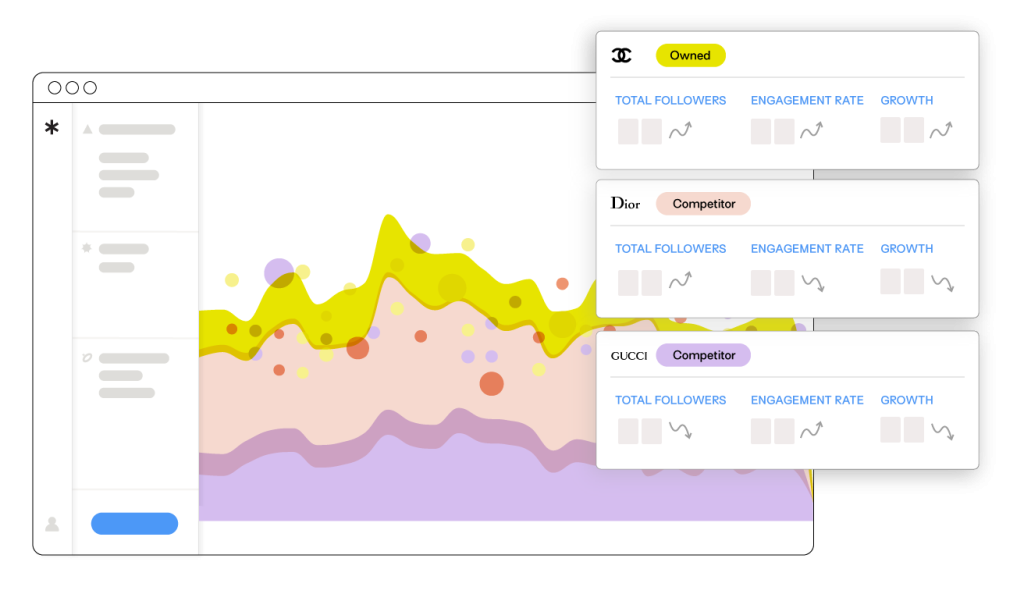
One standout feature of Pulsar CORE is its ability to monitor your competitors' channels beyond your own, offering a side-by-side performance benchmark. This comparative view reveals your strengths and highlights areas where your strategy could improve. In a snapshot below, you can see that the 'Owned' account - McDonald's - shows improvement across all metrics, while 'Competitors' like Burger King and KFC have seen declines in follower counts, impressions, growth, and engagement rates.
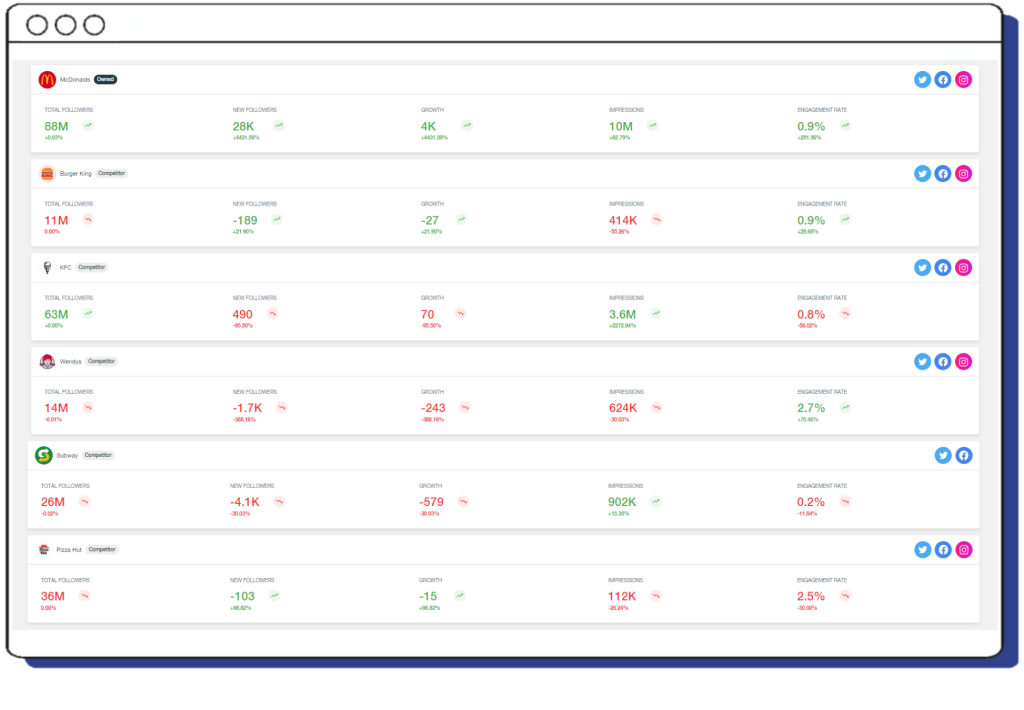
How do you analyze this?
Benchmarking yourself against competitors will reveal valuable insights into the effectiveness of your social media strategy. If you notice a decline in key metrics, identify the cause and reevaluate your current plan - whether you trial running paid campaigns or revamping your content style. Conversely, increases aren’t simply a win. Take the time to understand how you can sustain or build upon any growth and what triggered these increases - whether it was a particular campaign, seasonality, a new content format, etc.
Let's take a closer look at our ‘Owned’ account - McDonalds.
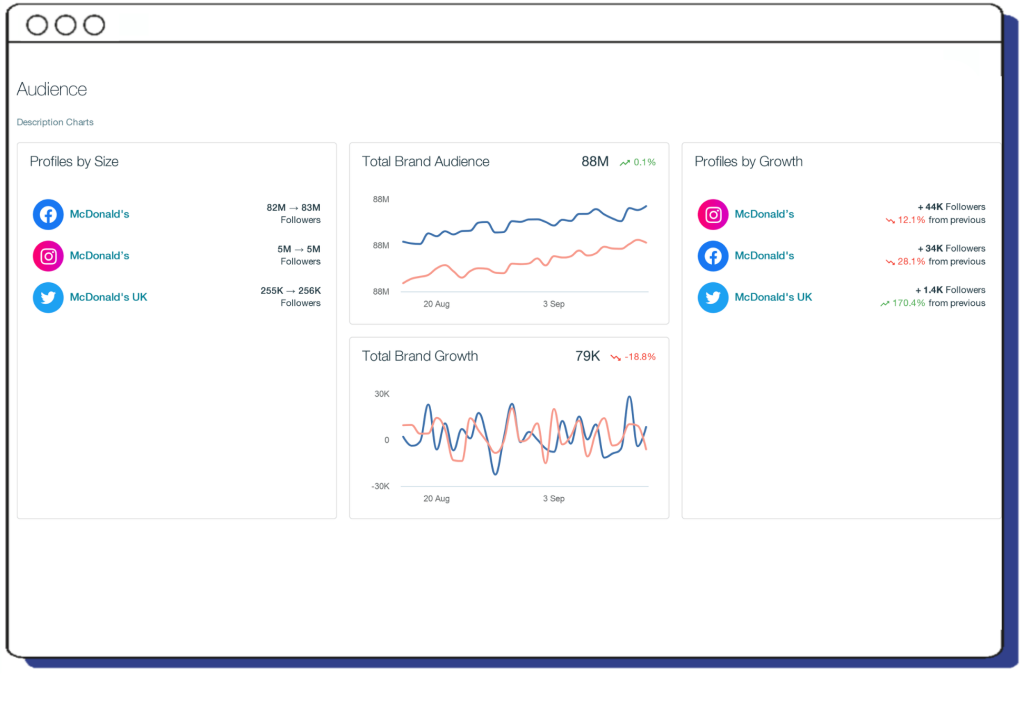
Explore your audience with Pulsar CORE. Get insights into your profiles by size within the selected period, total brand audience, total brand growth and your profiles by growth. Compare your progress to the previous period in an instant with a neatly packaged overview of your audience growth rate, from profile to profile.
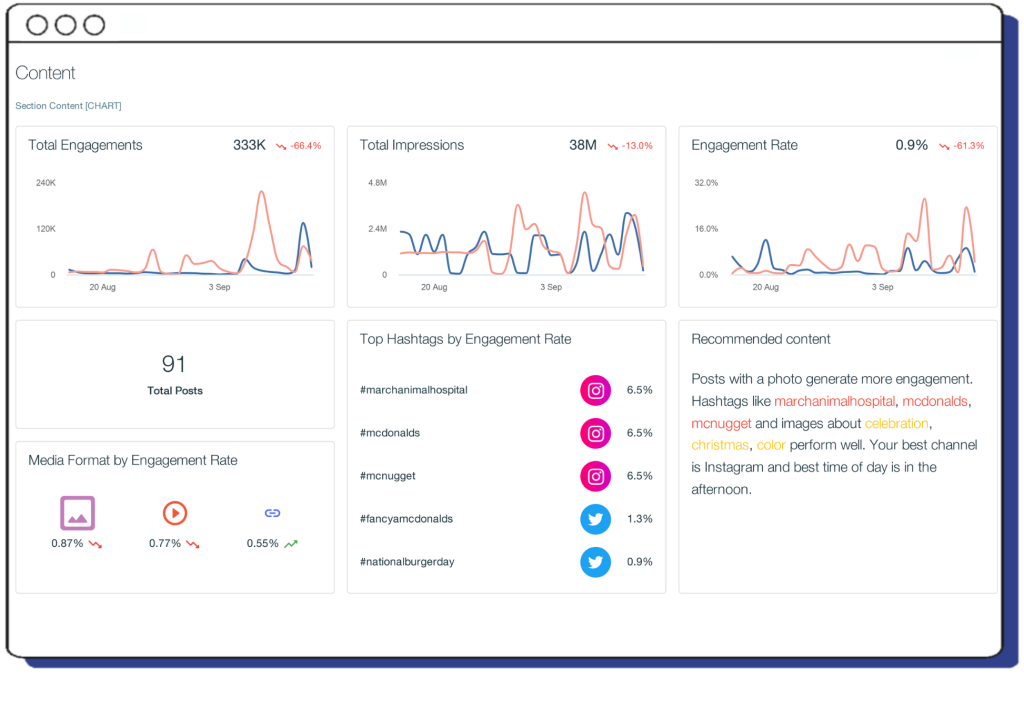
Next, measure your content performance. Get a snapshot of your total engagements, total impressions, engagement rate, your top media format and hashtags by engagement rate, plus recommendations for your content based on this analysis.
Enhancing your social media engagement strategy
Couple the essential social media metrics and engagement strategies with robust analytics tools like Pulsar CORE for optimal results. But, to go further, enhance your social media strategy with social listening through Pulsar TRAC. Surpass traditional social listening by combining it with audience segmentation for even deeper audience insights, but for a comprehensive view, delve into the difference between social listening and social monitoring for the complete picture.


